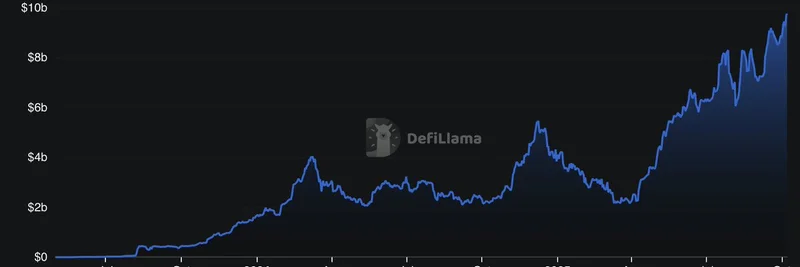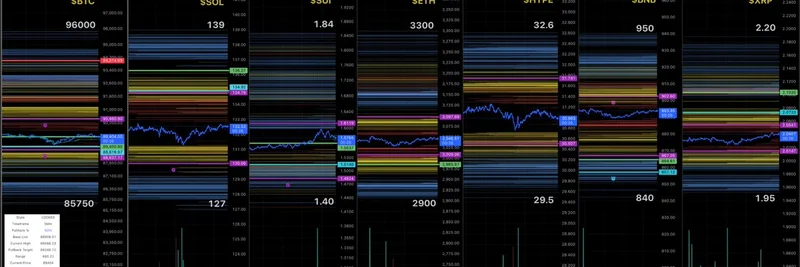In a recent tweet from Castle Labs, the spotlight was on Spark.fi's remarkable journey. From hitting lows of $2 billion in total value locked (TVL) back in March to surging to $9.7 billion today, this DeFi protocol is clearly on a roll. And now, they've dropped their roadmap for the next six months, packed with features that could make decentralized finance more accessible than ever.
As you can see in this chart from DeFiLlama, Spark's TVL has been climbing steadily, reflecting growing trust and adoption in the protocol. For those new to the space, TVL measures the total amount of assets locked in a DeFi platform—think of it as a gauge of how much money is actively being used there.
What is Spark.fi?
Spark.fi is a lending and savings protocol built within the MakerDAO ecosystem, now rebranded under Sky. It allows users to lend out their crypto assets like stablecoins or ETH to earn yields, or borrow against them. What sets Spark apart is its focus on safety, scalability, and now, user-friendly features. It's not just for crypto whales; the new updates aim to bring in everyday users looking for better returns than traditional banks.
Key Highlights from the Roadmap
The full roadmap, published on Mirror, outlines several exciting developments. Here's a breakdown:
Spark Mobile: A Neobank in Your Pocket
One of the standout announcements is Spark Mobile, set to launch early next year. Imagine a mobile app that lets you save, borrow, and even make payments seamlessly with your crypto. It's like a neobank—those digital-only banks without branches—but powered by blockchain. This could be a game-changer for onboarding new users, especially those tired of paltry bank interest rates. Instead of 0.5% APY from your savings account, you could earn 5-10% or more on stablecoins through DeFi, all from your phone.
Stablecoin Liquidity as a Service: Fueling the Stablecoin Boom
With stablecoins exploding in popularity—think USDT growing from $119 billion to $174 billion market cap in the past year—Spark is stepping in with "Stablecoin Liquidity as a Service." This means providing instant liquidity for new stablecoins or chains, helping them scale quickly. Using their Spark Liquidity Layer (SLL), which already manages $3.15 billion across protocols, Spark can bootstrap lending markets and DEX liquidity. Examples include supporting PayPal's PYUSD, with allocations growing to $1 billion soon. For blockchain practitioners, this service could mean easier integration for meme tokens or other projects needing stable liquidity to thrive.
Savings V2: More Assets, More Chains
Building on the success of Spark Savings, which has hit $620 million TVL across five chains, Savings V2 expands to include USDT and ETH vaults. No more worrying about swap liquidity; deposit your favorite asset on your preferred chain and earn a universal savings rate. For ETH, it'll start with yields from SparkLend and Lido's stETH. Launching this October on Ethereum mainnet (pending governance approval), it's designed for conservative, risk-adjusted returns.
Institutional Lending: Fixed Rates for Big Players
Aimed at institutions, Spark Institutional Lending uses Morpho V2 for direct, fixed-rate loans between lenders and borrowers. Unlike variable rates in pooled lending, this offers predictability. Spark's SLL ensures liquidity at market rates, with expected loan sizes scaling to over $1 billion. This ties into the broader trend of web2 fintechs like PayPal and Stripe going onchain, as regulations loosen up.
Automated Trading Operations: Enhancing Onchain Liquidity
In Q4, Spark plans to integrate with OTC desks, exchanges, and Uniswap V4 for automated swaps, handling over $100 million in stablecoin trades. This non-custodial setup boosts transparency—everything's verifiable on the blockchain. It positions USDS as a central hub for swaps, potentially improving liquidity for the entire DeFi ecosystem, including meme token traders who rely on quick, efficient exchanges.
Why This Matters for DeFi and Beyond
Spark's updates come at a pivotal time. With institutional adoption ramping up—thanks to laws like the GENIUS Act—DeFi is shifting from niche to mainstream. Projects like Spark are bridging the gap, offering institutional-grade tools while keeping things open and transparent. For the average user, it means higher yields without the complexity. And for developers in the meme token space, better liquidity services could mean faster growth for community-driven projects on emerging chains.
The tweet from Castle Labs nails it: Crypto projects are getting more regulatory freedom to innovate, like building mobile apps for DeFi. This could onboard millions, as people flock to higher APY on stables compared to banks. Keep an eye on Spark.fi—their trajectory suggests they're just getting started. If you're into blockchain, check out their app or data dashboard for more details.


